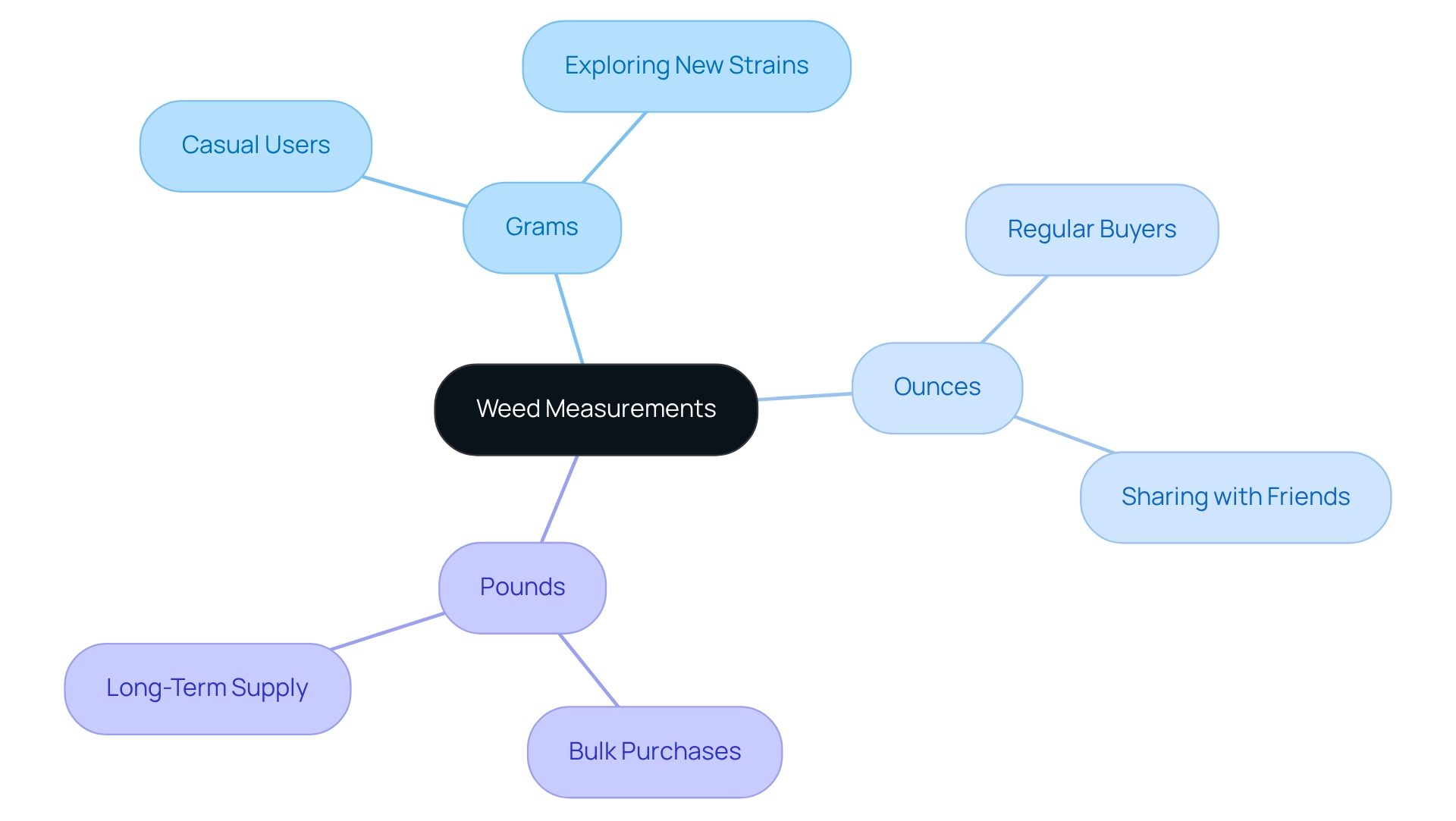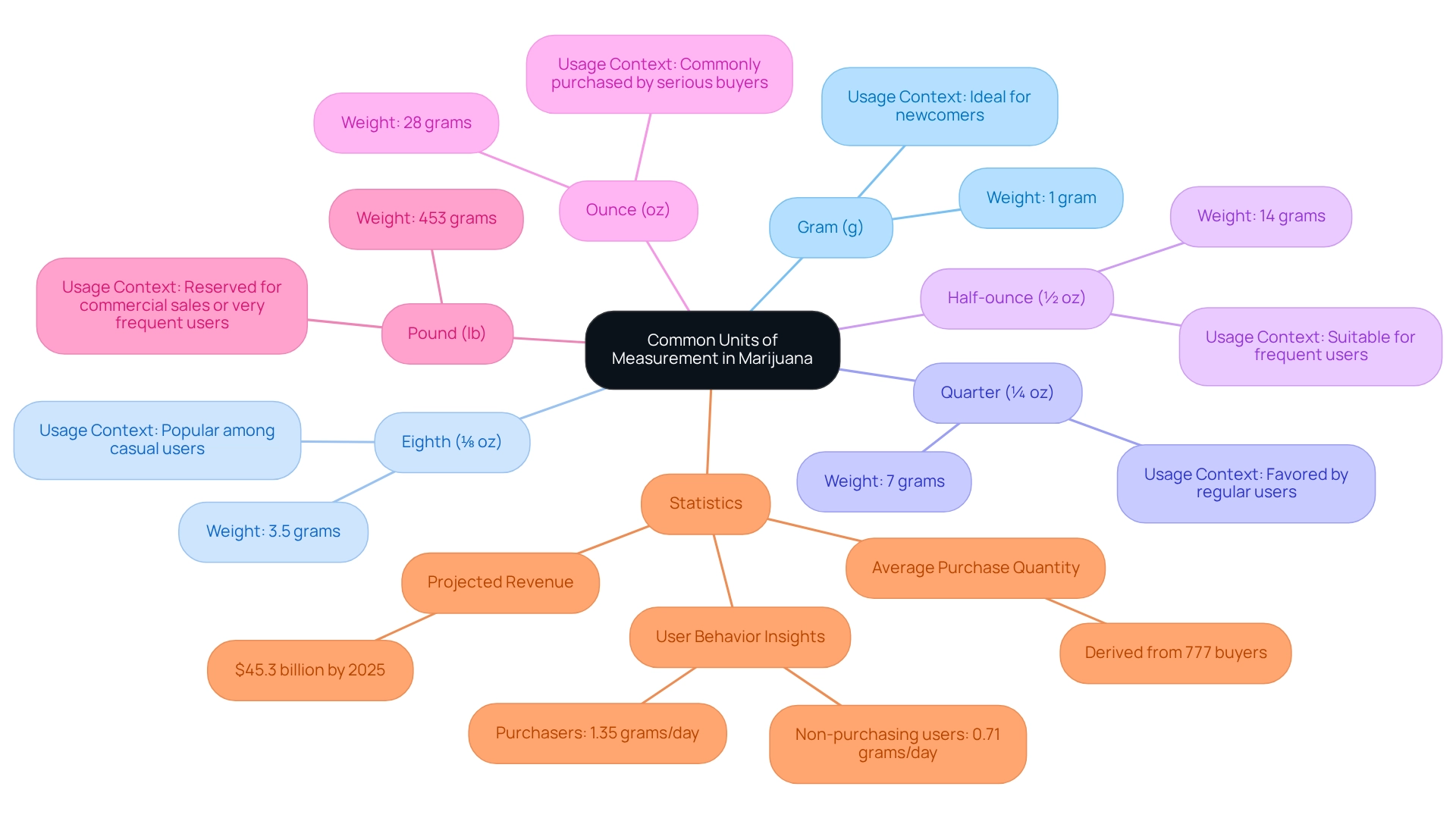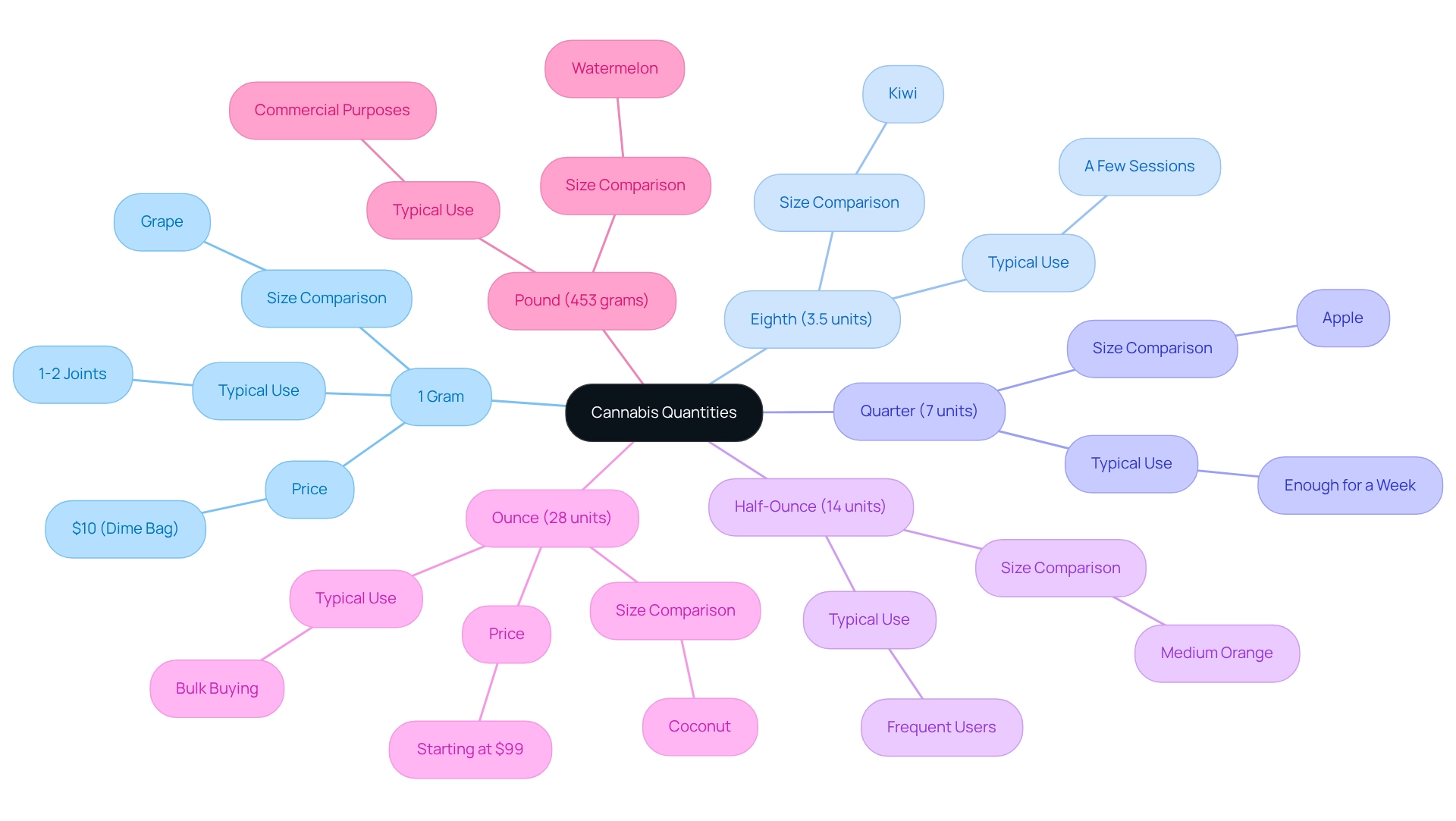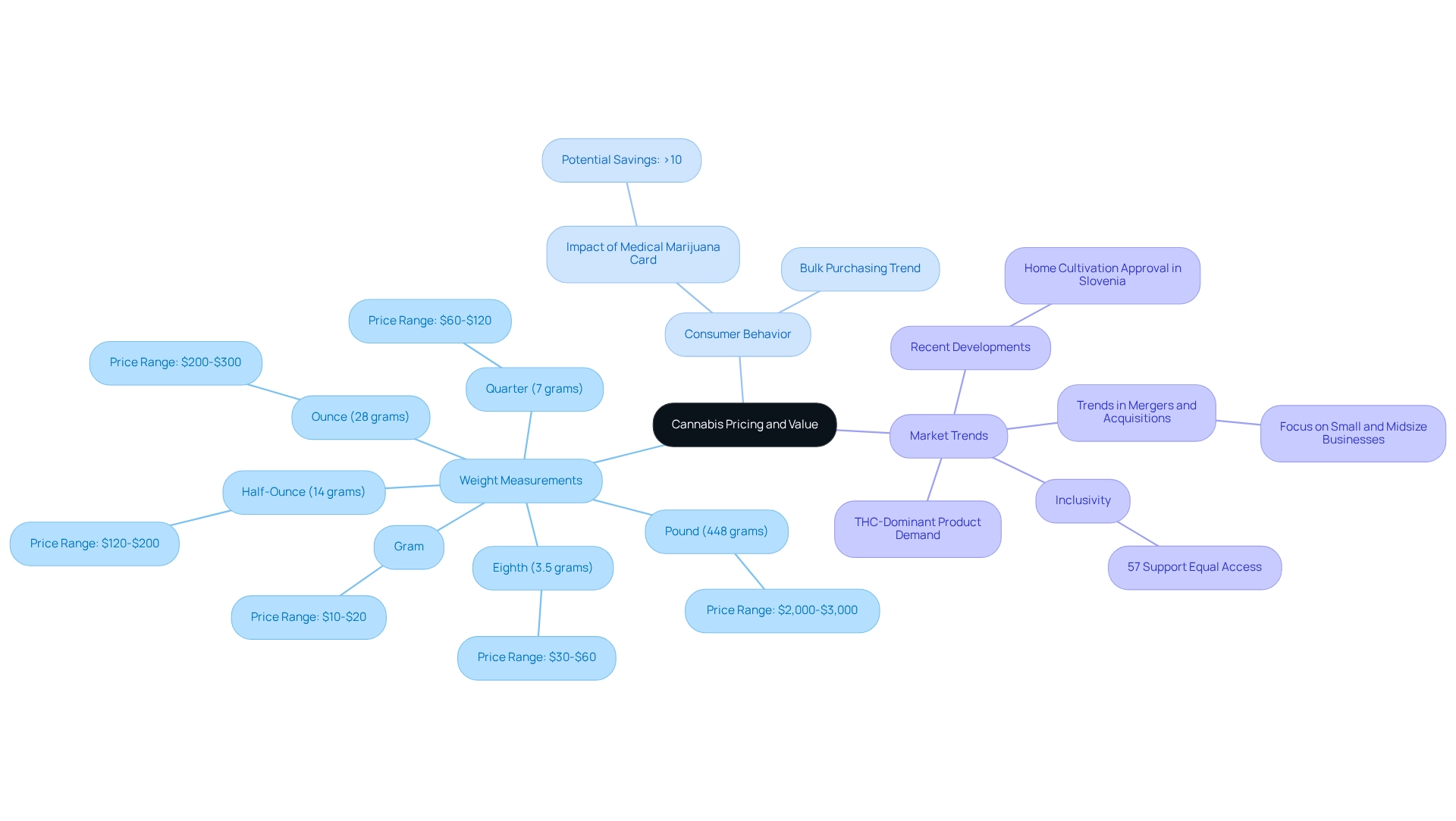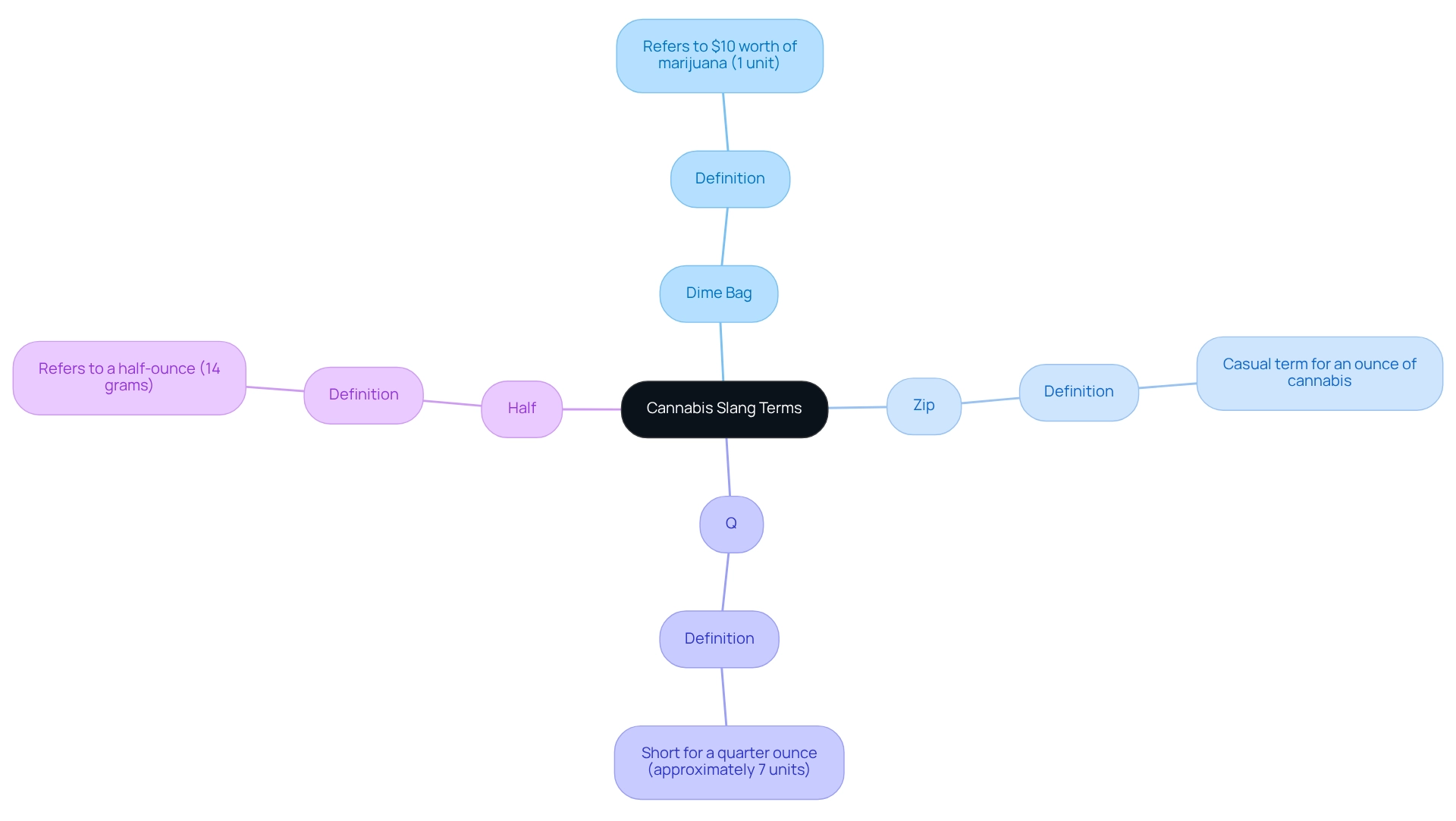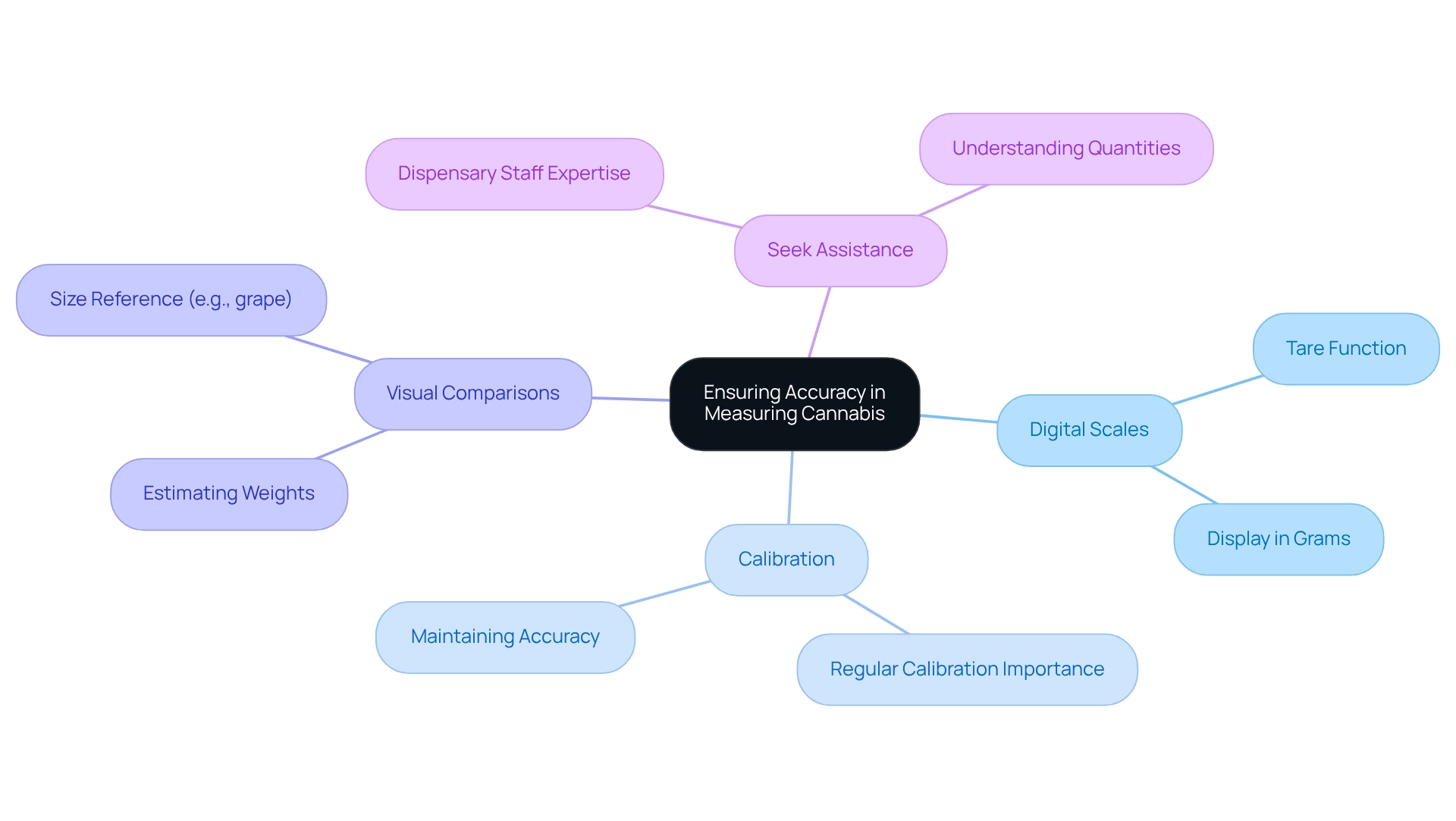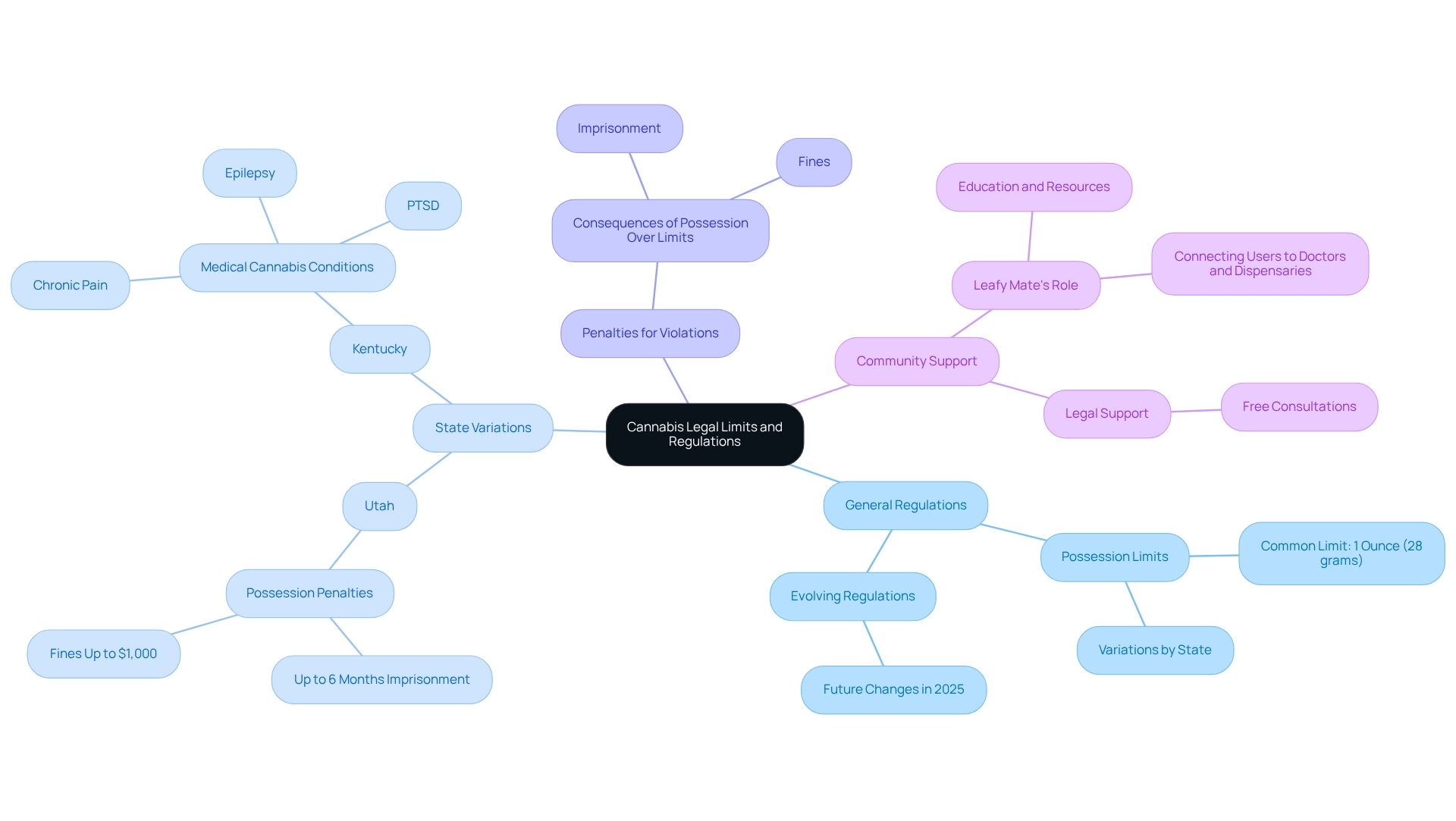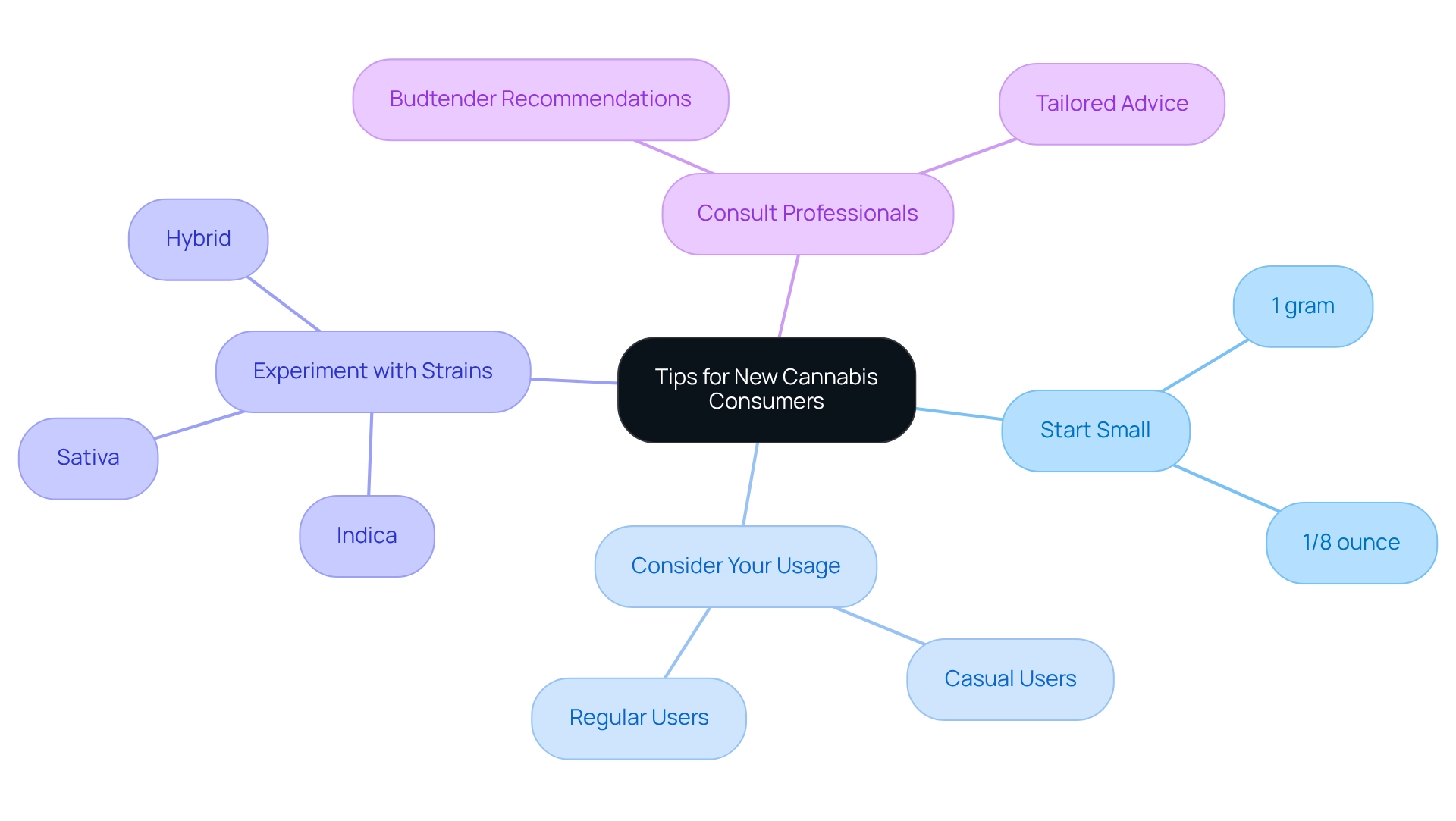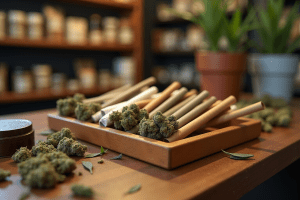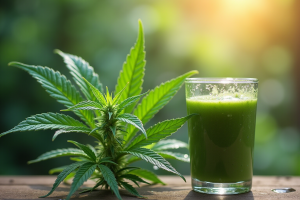Overview
Weed measurements are the various units we use to quantify cannabis, such as grams, ounces, and pounds. Understanding these measurements is essential for making informed purchasing decisions in the cannabis market. By grasping these concepts, you can compare prices and assess product value more effectively. This knowledge not only enhances your overall experience but also promotes responsible consumption and informed choices as the market continues to evolve.
Have you ever felt overwhelmed by the choices available? Knowing how to measure and understand cannabis can make a significant difference. It empowers you to make choices that align with your needs and preferences. Together, we can navigate this evolving landscape, ensuring that every decision you make is well-informed and thoughtful.
As you explore the cannabis market, remember that understanding weed measurements is your first step toward a rewarding experience. Let’s embrace this journey together, making choices that reflect our values and enhance our enjoyment.
Introduction
Navigating the world of cannabis can feel overwhelming, especially for those of us who are just starting to explore its diverse offerings. It’s not just beneficial to understand the various measurements and terminology associated with cannabis products; it’s essential for making informed purchasing decisions that lead to a positive experience. From grams to pounds, each unit of measurement is crucial in determining value, potency, and what suits your individual needs.
As the cannabis market continues to grow and change, we must equip ourselves with the knowledge to decipher these complexities. This knowledge empowers us to engage confidently with dispensaries and make choices that truly align with our preferences.
Together, let’s delve into the intricacies of cannabis measurements, providing valuable insights that will help you navigate this exciting landscape with ease.
Understanding the Basics of Weed Measurements
Understanding weed measurements is essential for anyone looking to navigate the cannabis market effectively. These measurements, primarily focused on weight, play a significant role in your purchasing decisions, pricing, and the strength of the products you choose. The most common units include ounces and pounds, each catering to different user needs.
For instance, a gram is often the smallest unit available, making it perfect for casual users who wish to explore a new strain without a hefty commitment. On the other hand, ounces and pounds are better suited for regular buyers or those looking to purchase larger quantities for personal use or sharing with friends.
The importance of grasping these units cannot be overstated. A clear understanding of weed measurements empowers you to compare prices effectively and assess the value of different products. For example, knowing that an ounce contains 28 grams can help you determine when you’re getting a better deal.
As the marijuana market continues to evolve, with THC-dominant products gaining traction due to their psychoactive effects, it’s crucial to equip yourself with the knowledge needed to make wise choices. Have you ever felt overwhelmed by the options available? You’re not alone. Statistics show that around 50,000 students in 8th, 10th, and 12th grades are surveyed annually about substance use, including marijuana, highlighting the growing interest among younger individuals. This underscores the need for comprehensive education on quantities and responsible usage.
Research indicates that understanding weed measurements significantly impacts purchasing choices. For example, as innovative THC-infused products, like beverages, enter the market, those who are knowledgeable about these units are more likely to make informed decisions that align with their preferences. Experts consistently stress the importance of education in this field, noting that informed individuals are better equipped to navigate the complexities of weed measurements.
Moreover, the trend toward easing policies and regulations worldwide emphasizes the necessity of public education to help you navigate these changes. Additionally, the anticipated rise of CBD-focused products, known for their non-intoxicating properties and medical benefits, further highlights the importance of understanding metrics for both THC and CBD items.
In conclusion, having a solid grasp of plant metrics not only empowers you as a consumer but also enhances your overall experience in the cannabis market. As this sector continues to expand and diversify, focusing on education regarding weight standards will be vital in promoting responsible consumption and informed decision-making. Together, let’s explore these options and make choices that best suit our needs.
Common Units of Measurement: Grams, Eighths, Quarters, and More
In the marijuana sector, understanding the various units of measurement is essential for making informed purchases at weed dispensaries. These retail establishments offer marijuana and related products for medical or recreational use, depending on local laws and regulations. Friendly professionals, known as budtenders, are there to help you choose the right products for your needs.
The most common units of weight include:
- Gram (g): This is the smallest standard unit, typically used for single purchases, making it ideal for newcomers wanting to explore different strains without a large commitment.
- Eighth (⅛ oz): Equivalent to 3.5 grams, this unit is a popular choice among casual users seeking a moderate amount for personal use.
- Quarter (¼ oz): This unit equals 7 grams and is often favored by regular users who prefer to stock up without opting for larger quantities.
- Half-ounce (½ oz): Approximately 14 grams, this unit suits those who use cannabis frequently, providing a balance between quantity and convenience.
- Ounce (oz): The standard bulk unit, roughly 28 grams, is commonly purchased by more serious buyers who want to ensure they have enough supply.
- Pound (lb): The largest unit, containing 453 grams, is typically reserved for commercial sales or very frequent users who require substantial quantities.
Understanding weed measurements is crucial for navigating dispensary offerings and making informed purchases. Did you know that the average total purchase quantity for flower and other marijuana products was derived from 777 buyers? This highlights the importance of these measurements in buying habits. Moreover, a study on marijuana buying and usage trends shows that many buyers prefer acquiring by units rather than ounces, which influences their purchasing decisions, with a notable percentage choosing smaller amounts.
As William C. Kerr pointed out, the average estimated typical quantity of non-purchasing users was 0.71 grams per day, compared to 1.35 grams for buyers. This difference underscores the importance of understanding weed measurements in relation to buying behavior. By grasping these concepts, you can make choices that align with your usage patterns and preferences, ultimately enhancing your experience in the marijuana market. Furthermore, as the landscape of marijuana laws evolves, as monitored by the State Cannabis Policy Enactment Database, staying informed is crucial for adapting your buying patterns.
This user manual aims to provide new marijuana users with the essential information needed to navigate the intricacies of dispensaries. Together, we can comprehend legal obligations and the role of Leafy Mate in assisting your product selections.
Breaking Down Cannabis Quantities: From Grams to Pounds
A marijuana dispensary is a welcoming retail establishment that offers marijuana and marijuana-related products for both medical and recreational use, depending on local laws and regulations. For consumers, understanding weed measurements is crucial in gauging their purchases accurately, especially with the diverse options available at dispensaries. Here’s a helpful breakdown of common measurements:
- 1 Gram: About the size of a grape, this amount typically suffices for one or two joints, making it a popular choice for casual users.
- Eighth (3.5 units): Roughly the size of a kiwi, an eighth is perfect for a few sessions, striking a balance between quantity and cost.
- Quarter (7 units): Similar in size to an apple, a quarter often provides enough for a week for moderate users, allowing for flexible consumption.
- Half-Ounce (14 units): Comparable to a medium orange, this quantity is ideal for frequent users who prefer to purchase without committing to a full ounce.
- Ounce (28 units): About the size of a coconut, an ounce is the largest quantity typically available for purchase and is often sought for bulk buying. As noted, “Since an ounce of weed is the largest size you can buy, it’s the most expensive. Despite this, some people find that buying larger amounts is more convenient and more valuable.” In Massachusetts, prices can start as low as $99, depending on quality and location, but this can vary significantly.
- Pound (453 grams): Comparable to a watermelon, this measurement is generally designated for commercial purposes or frequent users, representing a significant investment in cannabis.
Budtenders, the knowledgeable experts at dispensaries, are there to assist customers in selecting the right products based on their needs. This breakdown not only helps buyers visualize the scale of their purchases but also aids them in effectively planning their weed measurements. For example, a dime bag, which usually costs around $10, contains one gram of weed, while a dub refers to $20 worth, typically ranging between 1-2 grams.
Understanding these weed measurements can empower you to make informed choices, ensuring you receive the best value for your money. Additionally, a recent study on the demographic insights of marijuana users revealed that the average age of regular users is around 29.48 years, providing context for understanding consumption patterns within this population. Participants in industry events even received gift cards, highlighting public involvement in the marijuana market.
Referencing Bud’s Goods & Provisions, voted the #1 dispensary in Massachusetts, enhances the credibility of the discussion regarding pricing and quality. Dispensaries offer a wide range of marijuana products, including flower, edibles, concentrates, vape cartridges, topicals, and tinctures, further enriching your experience as a consumer. Together, we can navigate this evolving landscape, ensuring you feel informed and confident in your choices.
How Weed Measurements Affect Pricing and Value
The price of cannabis is closely tied to its weight, as evidenced by weed measurements, revealing a clear trend that typically favors bulk purchases. Generally, the more you buy, the lower the cost per unit becomes. For instance, acquiring an ounce often offers better value than purchasing several individual units.
Here’s a helpful pricing guide to navigate the market:
- Gram: $10-$20
- Eighth (3.5 grams): $30-$60
- Quarter (7 grams): $60-$120
- Half-Ounce (14 grams): $120-$200
- Ounce (28 grams): $200-$300
- Pound (448 grams): $2,000-$3,000
These prices can vary significantly based on several factors, including location, strain quality, and current market demand. As of 2025, the average price per gram of cannabis is expected to be around $15, reflecting ongoing buyer preferences for THC-dominant products, which continue to lead the market due to their psychoactive effects. Understanding these pricing structures, including weed measurements, is essential for budgeting effectively and making informed buying choices.
Moreover, the trend towards bulk purchasing is shaped by consumer behavior, as many seek to maximize value while minimizing costs. Have you considered how a medical marijuana card might enhance your purchasing power? It can lead to significant savings, including tax advantages, potentially saving you more than 10% on your purchases.
Leafy Mate serves as your comprehensive guide to exploring the marijuana landscape, providing reliable suggestions and insights into the best offers available. It also assists users in locating nearby dispensaries and physicians.
Interestingly, 57% of marijuana users advocate for equal access to industry opportunities, highlighting a growing awareness of inclusivity within the market. Recent developments, such as the June 2024 ballot approval allowing Slovenian adults to cultivate marijuana plants at home, suggest a shift towards enhanced accessibility and user empowerment.
Recent case studies indicate that marijuana pricing strategies based on weed measurements are evolving, with small and midsize businesses adapting to market corrections post-pandemic, thereby enhancing their competitive edge. As noted by Stef Swiergol, Director of Wholesale, “BDSA’s GreenEdge Enhanced Retail Sales tool has been instrumental in helping our budding brand assess our position in the marketplace. With its flexible interface, GreenEdge is my go-to for understanding our market.”
In summary, staying informed about current pricing trends and the relationship between weight, cost, and weed measurements empowers us to navigate the market more effectively. This ensures we find the best options tailored to our needs while leveraging the benefits of a medical marijuana card. Additionally, Leafy Mate’s promotional technology and advertising options can significantly enhance visibility and sales for the business. Together, let’s explore this evolving landscape with confidence.
Decoding Cannabis Slang: What Do Terms Like ‘Dime Bag’ Mean?
Marijuana slang can often be a source of confusion for newcomers. It’s essential to familiarize yourself with common terms to navigate conversations within the marijuana community effectively. Here are some commonly used slang expressions:
- Dime Bag: Traditionally, this term refers to $10 worth of marijuana, which typically amounts to around 1 unit. Understanding this term can help new buyers assess weed measurements and pricing when making purchases at dispensaries.
- Zip: A casual term for an ounce of cannabis, often used in everyday conversations among users. Knowing this term can promote smoother discussions about weed measurements.
- Q: Short for a quarter ounce, this term typically represents approximately 7 units. Familiarity with this slang can assist buyers in understanding the weed measurements of the product they are discussing or purchasing.
- Half: This refers to a half-ounce, or 14 grams, and is commonly used when talking about larger amounts of cannabis.
Grasping these terms is crucial for effective communication, especially when discussing weed measurements with dispensary staff or fellow users. Moreover, understanding marijuana terminology can greatly enhance your experience, fostering a sense of belonging within the community. At Leafy Mate, we aim to create a community of knowledgeable marijuana users through education and resource availability, making it essential for newcomers to grasp these concepts.
Consider the case study on Virginia’s marijuana culture, which highlights how local slang, shaped by regional artists and societal changes, influences the language among users. Terms like ‘zaza’ have emerged, reflecting both national trends and local nuances, illustrating the dynamic nature of marijuana terminology. This evolution of language is important as marijuana continues to gain acceptance, shaping how new users perceive and interact with the market.
As noted by the National Drug Intelligence Center, the primary active chemical in marijuana, tetrahydrocannabinol (THC), may induce relaxation and heighten the senses. Understanding marijuana terminology and weed measurements is crucial for new users to navigate their marijuana experience with enhanced confidence and clarity. Given that marijuana is the most commonly used federally illegal substance in the United States, familiarizing yourself with the associated slang is increasingly important for effective communication.
Additionally, the State Cannabis Policy Enactment Database provides up-to-date information on marijuana legislation, reflecting the evolving nature of the industry and its impact on consumer language. By becoming familiar with these terms and understanding weed measurements, newcomers can navigate their journey with greater confidence and clarity, ensuring they make informed decisions when visiting dispensaries and choosing products. It’s also important to understand the types of products available at dispensaries, such as flower, edibles, and concentrates, as well as their effects, along with the legal requirements and local laws governing their purchase and use.
Ensuring Accuracy: Tools and Tips for Measuring Cannabis
To achieve precise measurements when purchasing or using cannabis, it’s essential to utilize the right tools and techniques that can truly make a difference in your experience:
-
Digital Scales: These are the gold standard for measuring cannabis accurately. Choosing scales that display measurements in grams and have a tare function allows you to weigh containers without adding their weight to the final measurement.
-
Calibration: Regularly calibrating your scale is vital for maintaining accuracy. This process ensures that your scale provides reliable readings, which is crucial for both purchasing and personal use.
-
Visual Comparisons: Familiarizing yourself with visual cues can aid in estimating weights. For instance, a gram of marijuana is approximately the size of a grape, helping you estimate amounts when a scale isn’t accessible.
-
Seek Assistance: Don’t hesitate to ask dispensary staff for help with measuring or understanding marijuana quantities. Their expertise can provide valuable insights and ensure you receive the correct amount.
Accurate weed measurements are not only essential for ensuring you get what you pay for but also play a significant role in managing your consumption effectively. Have you noticed a growing emphasis on precision in the market? Statistics indicate that the usage of digital scales for weed measurements among marijuana consumers is on the rise. As Sarah Stith from the University of New Mexico observes, “As the marijuana product landscape is changing rapidly, nationally representative data on product types, consumption modes, and potencies are needed to understand the effects of legalization and commercialization on marijuana product characteristics and population health.”
This highlights the significance of precise weed measurements in navigating the changing landscape of marijuana.
Furthermore, the dependability of assessment tools is essential. For example, the daily sessions factor shows a Cronbach’s alpha of .69, indicating some variability in assessment reliability. A case study on the approach for assessing marijuana-related exposure demonstrates the connection between digital media exposure and marijuana usage, offering a framework for comprehending how precise evaluations can affect buyer behavior. As the scenery changes, the trust we possess in our evaluations can greatly influence our overall experience and satisfaction with marijuana products. Together, let’s ensure we make informed choices that enhance our enjoyment and understanding of cannabis.
Legal Limits and Regulations: What You Need to Know About Cannabis Measurements
Legal limits for weed measurements can vary significantly across states, which directly influences how much marijuana individuals can possess or purchase. In many jurisdictions, adults are allowed to possess up to one ounce (28 grams) of marijuana. However, it’s important to note that some states impose stricter limits, while others may allow for larger quantities, reflecting a diverse regulatory landscape.
For instance, in Utah, possessing less than 100 pounds can lead to serious consequences, including up to six months of imprisonment and fines reaching $1,000 for first or second offenses. These penalties highlight the importance of adhering to local regulations. At Leafy Mate, we strive to create a community of knowledgeable users through education and resource availability, ensuring everyone feels supported in their choices.
Understanding weed measurements in relation to legal limits is crucial for making informed decisions about purchases and consumption. As marijuana regulations evolve, especially in 2025, it’s essential for individuals to stay informed about their state’s specific laws to avoid potential legal issues. This knowledge not only aids in responsible consumption but also influences purchasing decisions, as consumers may gravitate toward products that align with their legal allowances.
Leafy Mate serves as a comprehensive guide, connecting users to reliable marijuana doctors and dispensaries while also offering educational resources about the various products available. Consider case studies like Kentucky’s acknowledgment of qualifying conditions for medical marijuana—including chronic pain, epilepsy, and PTSD—demonstrating how legal frameworks can enhance access to marijuana for those in need. By fostering a community of informed individuals, Leafy Mate empowers people to navigate these complexities effectively, ensuring they understand both the legal landscape and the implications of their decisions in the marijuana market.
As Bridget Molitor, J.D., emphasizes, “This article has been written and reviewed for legal accuracy, clarity, and style by FindLaw’s team of legal writers and attorneys and in accordance with our editorial standards.
Choosing the Right Amount: Tips for New Cannabis Consumers
For new marijuana users, figuring out the right weed measurements to purchase can feel overwhelming. We understand that making informed choices is essential, so here are some essential tips to help you navigate this journey:
- Start Small: It’s advisable to begin with a gram or an eighth of an ounce. This allows you to gauge your tolerance without overcommitting.
- Consider Your Usage: Reflect on how frequently you plan to use marijuana. Casual users may find that smaller quantities suffice, while those who use it more regularly might need to adjust their purchases accordingly.
- Experiment with Different Strains: Different cannabis strains can produce varying effects. Indica strains are known for their relaxing effects, while Sativa strains can be uplifting and energizing. Hybrid strains offer a balance of both. Trying a few can help you identify which ones align best with your preferences and needs.
- Consult with Professionals: Don’t hesitate to seek advice from dispensary staff, known as budtenders. They can provide tailored recommendations based on your experience level and desired effects, ensuring you make informed choices.
Research indicates that many new buyers tend to purchase around 3.5 grams (an eighth) on their first visit, which is a manageable amount for weed measurements and experimentation. Furthermore, expert suggestions can greatly influence buying decisions, directing individuals toward products that match their specific requirements.
With California having 3,659 marijuana dispensaries, new consumers have ample access to products and expert advice. A case study from GOOD DAY FARM dispensaries highlights the importance of quality and informed choices. They emphasize the advantages of marijuana over pharmaceuticals, creating a unique shopping experience that caters to both novice and seasoned users.
By starting small and gradually increasing your intake, you can discover the right weed measurements that suit you, ensuring a positive and responsible experience.
Furthermore, cannabis has been shown to effectively reduce anxiety and depression symptoms in people with post-traumatic stress disorder, which may encourage new consumers to explore its therapeutic benefits. As Laura A. Bianchi, founding partner of Bianchi & Brandt, cautions, “Others are entering into bad partnerships out of desperation, and we will likely see them in court in the future.” This highlights the importance of making informed decisions when choosing products and dispensaries.
Conclusion
Understanding cannabis measurements goes beyond mere numbers; it’s about empowering you, the consumer, to make informed decisions that enhance your overall experience in the cannabis market. From the smallest units like grams to larger quantities such as ounces and pounds, recognizing these measurements is crucial for assessing value, potency, and suitability for your individual needs. As the market evolves, being well-versed in these units not only aids in effective price comparison but also fosters responsible consumption.
The significance of cannabis slang and terminology cannot be overlooked, as it can often create barriers for newcomers. Familiarity with terms like “dime bag” or “zip” can enhance communication and build a sense of community among users. Moreover, understanding legal limits and regulations is paramount for navigating the complexities of cannabis consumption and ensuring compliance with local laws.
Utilizing the right tools for measuring cannabis, such as digital scales, can significantly improve accuracy and enhance your experience as a consumer. As the landscape of cannabis continues to change, staying informed about current pricing trends and market dynamics is essential for maximizing value.
Ultimately, knowledge is power in the cannabis world. By equipping yourself with a solid understanding of measurements, slang, legalities, and pricing, you can confidently engage with dispensaries and make choices that align with your preferences. This journey towards informed consumption not only enriches your personal experiences but also contributes to a more responsible and educated cannabis community. Together, let’s embrace this knowledge and foster a supportive environment for all.
Frequently Asked Questions
Why is understanding weed measurements important?
Understanding weed measurements is essential for making informed purchasing decisions, comparing prices, and assessing the strength of cannabis products in the market.
What are the most common units of weed measurement?
The most common units of weed measurement include grams, eighths (3.5 grams), quarters (7 grams), half-ounces (14 grams), ounces (28 grams), and pounds (453 grams).
Who can assist you in making product selections at a dispensary?
Budtenders, who are knowledgeable professionals at dispensaries, can help you choose the right cannabis products based on your needs.
What is the smallest unit of measurement for cannabis?
The gram is the smallest standard unit of measurement for cannabis, typically used for single purchases.
What unit is popular among casual users seeking a moderate amount of cannabis?
The eighth (⅛ oz), which is equivalent to 3.5 grams, is a popular choice among casual users.
How do larger units like ounces and pounds cater to different users?
Ounces (28 grams) are commonly purchased by serious buyers for bulk supply, while pounds (453 grams) are typically reserved for commercial sales or very frequent users needing substantial quantities.
How does understanding weed measurements impact purchasing choices?
Knowledge of weed measurements helps consumers make informed decisions that align with their preferences, particularly as new THC-infused products enter the market.
What is the significance of education regarding weed measurements?
Education on weed measurements is crucial for navigating the evolving marijuana market and promoting responsible consumption.
How do buying habits vary among users?
Research indicates that non-purchasing users typically consume about 0.71 grams per day, while buyers average 1.35 grams, highlighting the importance of understanding measurements in relation to usage patterns.
What role does Leafy Mate play in assisting new marijuana users?
Leafy Mate aims to provide essential information to help new marijuana users navigate dispensaries and understand legal obligations related to cannabis purchases.

